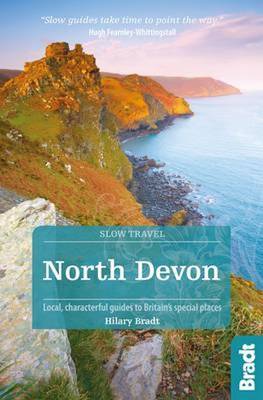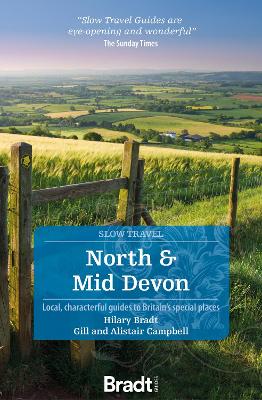Bradt Travel Guides (Slow Travel series)
5 total works
This new second edition of South Devon and Dartmoor is part of Bradt's distinctive 'Slow travel' series of guides to UK regions, offering in-depth exploration of one of England's most popular areas. Written by resident experts Hilary Bradt and Janice Booth, it is the essential companion guide to discovering not just the obvious and most popular sites, but also for getting off the beaten track and understanding what makes this gorgeous part of the country tick.
Much of the information in Bradt's South Devon and Dartmoor has appeared in no other guidebook (apart from the first edition of this book) as the authors uncover the lesser-known charms of the region as well as different aspects of the more popular places, together with colourful characters from the past, folk history, and literary links from Agatha Christie to Conan Doyle. The guide has a special emphasis on car-free travel: walking, cycling and river boats, as well as local buses and trains. Local food is covered, while accommodation and places to eat and drink have been hand-selected by the authors, from idyllically located campsites to stylish boutique B&Bs, with additional advice from a Devon-based tour operator who has personally tested many restaurants and hotels.
Colourful and witty writing, along with the authors' enthusiasm for their subject, makes the guide a pleasure to read. With Bradt's South Devon and Dartmoor discover the region's award-winning gin distillery and new whisky distillery; learn what really goes on at a wassail gathering; find out what you should do if you're harassed by pixies on Dartmoor; and discover unique local events like the annual Orange Race held in Totnes. Also included are selected walking routes with maps, and entertaining and informative stories about historical characters and folklore, while small and historic little village churches, with their idiosyncratic saints and intriguing carvings, are described in loving detail. Wet weather activities are also suggested for each area.
Much of the information in Bradt's South Devon and Dartmoor has appeared in no other guidebook (apart from the first edition of this book) as the authors uncover the lesser-known charms of the region as well as different aspects of the more popular places, together with colourful characters from the past, folk history, and literary links from Agatha Christie to Conan Doyle. The guide has a special emphasis on car-free travel: walking, cycling and river boats, as well as local buses and trains. Local food is covered, while accommodation and places to eat and drink have been hand-selected by the authors, from idyllically located campsites to stylish boutique B&Bs, with additional advice from a Devon-based tour operator who has personally tested many restaurants and hotels.
Colourful and witty writing, along with the authors' enthusiasm for their subject, makes the guide a pleasure to read. With Bradt's South Devon and Dartmoor discover the region's award-winning gin distillery and new whisky distillery; learn what really goes on at a wassail gathering; find out what you should do if you're harassed by pixies on Dartmoor; and discover unique local events like the annual Orange Race held in Totnes. Also included are selected walking routes with maps, and entertaining and informative stories about historical characters and folklore, while small and historic little village churches, with their idiosyncratic saints and intriguing carvings, are described in loving detail. Wet weather activities are also suggested for each area.
East Devon & the Jurassic Coast (Slow Travel)
by Hilary Bradt and Janice Booth
Published 16 February 2016
Slow East Devon and the Jurassic Coast is the most comprehensive - and only standalone - guide available to this region. With publication timed to coincide with the opening of the Seaton Jurassic Centre, here is insider knowledge which can only be gained by living in the area. Contributions from local experts, and colourful and witty writing combined with the authors' enthusiasm, make this guide as much a pleasure to read as an invaluable companion for exploring. Exeter and the Exe Estuary get a chapter of their own, and parts of Mid Devon, including Tiverton, are covered in detail, along with East Devon's most alluring chunks of countryside and the seaside resorts of Sidmouth, Budleigh Salterton and Beer. The chapter on West Dorset describes Lyme Regis and Charmouth along with brief descriptions of other coastal towns. An explanation of the geology of the entire World Heritage Site of the Jurassic Coast links the whole region. With an emphasis on car-free travel - walking, cycling and local buses - the detailed descriptions, historical and folk anecdotes, and personal accounts encourage visitors to explore each locale thoroughly. Hand-picked places to eat and drink, including all the eateries along the main artery of the A3052, are selected by the authors based upon long-standing knowledge of the area.
North Devon, with its long sandy beaches and little coves, is the favourite of families with small children, while Exmoor's heather-covered moorland and deep, wooded coombes, attract walkers, mountain bikers, and riders. Some of the prettiest villages in the south west are found here, with cream teas aplenty. Much information will be unique to this guidebook, blending descriptions of little-known places and country pursuits with portraits of local characters, past and present. The book will be geared towards sustainable tourism, with special emphasis on car-free travel, walking, local food, pubs and unusual or special accommodation.
This new, thoroughly updated edition of Bradt's award-winning North Devon & Exmoor remains the only dedicated general guide to this compelling area. North Devon's relative inaccessibility has been a deterrent to ugly development, and Exmoor National Park is one of the smallest, least well known, and utterly delightful of all national parks. The rugged western cliffs around Hartland Point are the most dramatic in Devon and the cliff-top walking some of the best. New to this edition are several nature reserves which didn't make it into the first edition and more in-depth descriptions of the far western part of Devon abutting the Cornish border. Also included are the Gnome Reserve and the Bakelite Museum - just two of several quirky places in the region - and expanded information on the island of Lundy in the Bristol Channel, as well as unique coverage of the whole of Exmoor National Park straddling Devon and Somerset. Particularly intriguing are the many descriptions of country churches, 'the storerooms of history'.
The North Devon and Exmoor region is arguably the most scenic in the southwest. No other has this blend of wild rugged coastline, deep river valleys, heather-covered moorland, family-friendly sandy beaches, great surfing and enchanting villages. Some of the prettiest villages in the southwest are found here, with cream teas aplenty. Much information is unique to this guidebook, blending descriptions of little-known places and country pursuits with portraits of local characters, past and present. The guide also places special emphasis on car-free travel, walking, local food, pubs and unusual or special accommodation. Whether you like to spend time exploring National Trust properties, discovering gardens, wildlife watching (Exmoor is home to Britain's largest mammal, the red deer), or indulging in more active pursuits such as coasteering, kayaking or just a gentle pony trek, Bradt's North Devon & Exmoor is the ideal companion for a successful visit.
The North Devon and Exmoor region is arguably the most scenic in the southwest. No other has this blend of wild rugged coastline, deep river valleys, heather-covered moorland, family-friendly sandy beaches, great surfing and enchanting villages. Some of the prettiest villages in the southwest are found here, with cream teas aplenty. Much information is unique to this guidebook, blending descriptions of little-known places and country pursuits with portraits of local characters, past and present. The guide also places special emphasis on car-free travel, walking, local food, pubs and unusual or special accommodation. Whether you like to spend time exploring National Trust properties, discovering gardens, wildlife watching (Exmoor is home to Britain's largest mammal, the red deer), or indulging in more active pursuits such as coasteering, kayaking or just a gentle pony trek, Bradt's North Devon & Exmoor is the ideal companion for a successful visit.
North & Mid Devon (Slow Travel)
by Hilary Bradt, Gill Campbell, and Alistair Campbell
Published 23 May 2022
A brand new title, part of Bradt's award-winning series of Slow travel guides to UK regions, offering the most in-depth coverage available to North and Mid Devon, arguably the most beautiful and unspoilt countryside in southwest Britain. With area-by-area coverage, from around Clovelly and the Cornish border in the north to Mid Devon's Exe Valley and Tarka railway line, it is packed with suggestions for where to go and what to do, including plenty of outdoor activities such as horseriding, coasteering, walking and cycling. Interesting places to stay and eat are detailed, as are festivals, local customs and traditions, historical aspects, anecdotes, gardens, National Trust properties and where to go stargazing beneath the region's Dark Skies.
North Devon has a unique blend of wild rugged coastline, deep river valleys, heather-covered moorland, family-friendly sandy beaches, great surfing and enchanting villages. While the car-free village of Clovelly provides a glimpse of Devon as it was 100 years ago, North Devon is also one of the country's leading centres for coasteering. Mid Devon is the least touristy part of the southwest - truly Slow Devon. The towns still hold weekly pannier markets and the pubs are full of locals discussing the price of sheep and Ruby Red cattle. People still walk, ride and cycle as part of their lives and visitors are always struck by the region's diversity: the wonderful views, the range of wildlife and the clarity of the night skies.
Join veteran traveller, author and Devon resident Hilary Bradt, and her fellow long-term travellers and Devon residents Gill and Alistair Campbell, to discover in this unique guide exactly what it is that makes this beguiling region so special. From Lundy Island to the haunted village of Lapford, and from the extraordinary Dingles Fairground Heritage Centre to the War Horse Museum, Bradt's Slow Mid and North Devon has everything you need for a perfect trip.
North Devon has a unique blend of wild rugged coastline, deep river valleys, heather-covered moorland, family-friendly sandy beaches, great surfing and enchanting villages. While the car-free village of Clovelly provides a glimpse of Devon as it was 100 years ago, North Devon is also one of the country's leading centres for coasteering. Mid Devon is the least touristy part of the southwest - truly Slow Devon. The towns still hold weekly pannier markets and the pubs are full of locals discussing the price of sheep and Ruby Red cattle. People still walk, ride and cycle as part of their lives and visitors are always struck by the region's diversity: the wonderful views, the range of wildlife and the clarity of the night skies.
Join veteran traveller, author and Devon resident Hilary Bradt, and her fellow long-term travellers and Devon residents Gill and Alistair Campbell, to discover in this unique guide exactly what it is that makes this beguiling region so special. From Lundy Island to the haunted village of Lapford, and from the extraordinary Dingles Fairground Heritage Centre to the War Horse Museum, Bradt's Slow Mid and North Devon has everything you need for a perfect trip.




